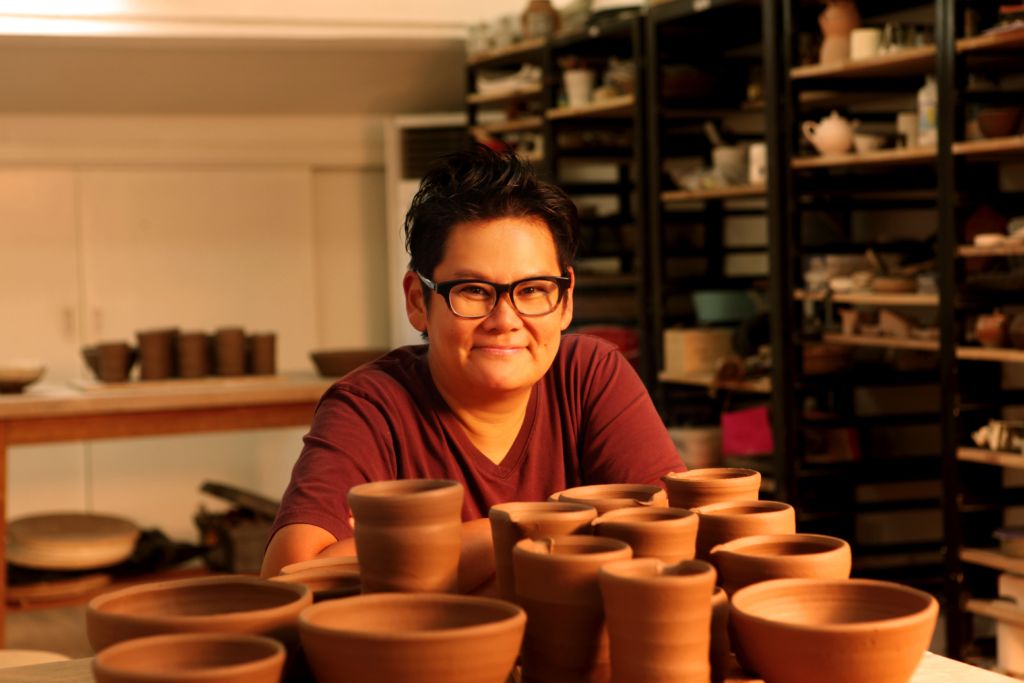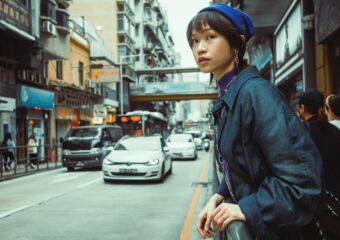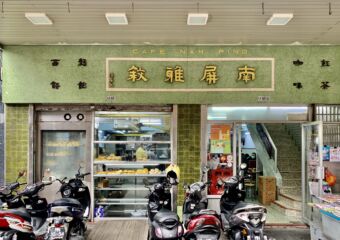Despite being one of the oldest mediums of art and self-expression, ceramics have always taken a back seat in the world of contemporary art. And while many of us take for granted these ceramic traditions that have evolved from ancient Greecian times to its dominance in Asia, dedicated artists have continued to preserve, excel and innovate in this fascinating craft.
There is no better place to understand and believe in its essence than at the ongoing Art Macao. There is certainly no one better to talk about the topic and curate a magnificent exhibition on gorgeous ceramics than the renowned artist Caroline Yi Cheng. Executive Director of The Pottery Workshop and Yi Design, Cheng is a name that echoes in the international scene not just as a designer but also as a curator. Her studios in Hong Kong, Shanghai, Jiangxi Province, and Dali are devoted to championing ceramics in China and the world. Her remarkable pieces are collected and showcased by the British Museum, Museum of Fine Arts, Boston, Asian Art Museum of San Francisco, The Ceramic Museum – Vallauris Golfe-Juan, France and The Fitzwilliam Museum, Cambridge.
While we’ve certainly met many artists covering the incredible Art Macao, meeting Caroline on the steps of The Venetian Macao was a breath of fresh air. For many creatives, the art process can be a soul siphoning journey that requires huge intellectual and emotional endurance and there are a few who truly radiate honesty, enthusiasm, and passion with pure joy after decades in their chosen field. Caroline is certainly a shining example of enthusiasm as she exclaims how great an honor it has been to curate such a magnificent international exhibition for Art Macao. Elaborating about her work on “All That’s Gold Does Glitter – An Exhibition of Glamorous Ceramics”, she says, “The exposure is simply incredible. Can you believe that the lobby has already welcomed four million people who have probably seen the exhibition? It’s just fantastic. There’s probably around ten million who have seen the exhibition in a subliminal way. The children will stop, gaze and make the parents look as well. It’s such a powerful way to be exposed to different forms of art and ceramics to be specific.”

Group photo of all officiating guests and attending artists
How did you choose these specific artists that took part in this exhibition? What were the criteria?
First and foremost, I expected all the artists that I invited to be making work by themselves. They are all internationally renowned artists. They should have the skill and must have beautiful work. Just look at the venue, it’s The Venetian Macao’s lobby that looks like a grand palace. It’s a busy floor and it was certainly a challenge to put something in that space. The booths are gold-laden so the work inside should be made by a well-skilled artist. My mission was to showcase art from all over the world but I also wanted 40% of the artists to be women because we should showcase females who are passionate and talented in their chosen field. Most of the pieces were done specifically and exclusively for this exhibition.
There are originally 30 pieces up the ballroom area, 50 pieces down here and dotted around the museum and other hotels. That’s around 90 pieces of work spread out and 30 artists who contributed but some of them have passed away already. I wanted to incorporate gold into the overall theme and sand represented on ceramics. The touch of gold really stands out as manifested in many of the pieces.
There are some amazing international artists present at the exhibition, what were their reactions about being part of Art Macao?
The people who came were blown away. Ceramics has always been non-mainstream art. People ask, “Why is it so expensive when it’s only ceramics?” To put an international ceramic exhibition together is a challenging process. It’s easy to fail because people would rather spend on paintings or sculptures. However, this time around the artists felt as though they were treated like kings and it’s really a huge milestone here at Art Macao. We made sure to lead because we wanted to showcase and exhibition that all of us can truly be proud of in every sense of detail. We also wanted engagement and thus reached out to the community and universities. And I must say, the artists are talking about Macau up to this day and they are all praises about it.
For those who aren’t sure whether to visit the exhibition or not, what do you think makes it so special?
There are amazing artists in this exhibition. While every enthusiast or person comes to see a few pieces, there is enough artwork for everyone to connect with. It’s an exhibition on an international scale and it’s right here in the heart of Macau. This is such a great opportunity to witness these creations and people should truly explore and see it for themselves.

Ceramic butterfly dress “Prosperity”, by Caroline Yi Cheng
Do you have a favorite piece from the exhibition and why?
(Laughs) I love my own piece! As a curator, I really shouldn’t be displaying my work but Sands China Ltd. insisted so for next year I am thinking of who can replace me. I like Japanese ceramicist Tetsuya Ishiyama’s piece but overall I love all of the pieces in this exhibition.
Where did your idea for the butterfly dresses come from? How many butterflies are on the dresses and how long did they take to make?
My idea came from Jingdezhen province. It is known as the “Porcelain Capital” because it has been producing Chinese ceramics for thousands of years and that’s such a glorious history. I stumbled upon a craftsman and I asked him, “Can you put a hole in the butterfly?”. He was apprehensive at first but he eventually accepted my request and that was the beginning of it all. With creativity, there’s a need to innovate while understanding the deep and rich history of your chosen medium.
How long did it take to create the dresses?
The gold pieces are commissioned for this space but some of the pieces are ones I already have. I always tell people, it took me 40 years and five minutes to create artwork. It’s a combination of 40 years of looking at things as an artist and five minutes of a phone call into the actual creation (laughs). It’s a journey or a process in itself.
What inspires you and your art?
Everything inspires me. I am also inspired to make a piece that a museum can collect, something beautiful but with quality craftsmanship that’s really intricate. My work can be viewed from far away as a symbol of the orient just like China. But if you look closely, everything is handmade and different. It’s almost as if you’re looking into a map of China but as you traverse inside you will realize that you can spend a lifetime looking but that it never ends because they’re not the same at all. Every butterfly is different and unique in their own way. I never really think of my legacy; I just want people to look at ceramics in a different way. For me, art should have a lot of meaning in it; It has to be purposeful.
What was your path like to becoming an artist? Did you always want to work with ceramics?
From the age of 12 to 22, I worked with animals and I thought I wanted to be a veterinarian. When I was in university, I took elective classes in art. However, my grandparents were literati in art. I grew to like art so I graduated in both zoology and art eventually. I eventually went to the Academy of Art College, San Francisco and met with talented teachers in the art field. In 1985, when the internet was just beginning, one of my distinguished professors introduced me to it so my background was actually developed in visual art and video art performances.
Along my journey, I saw Jeff Koons and I saw crafts and was motivated. I wasn’t thinking too much about it back then but I liked it so much that I bravely took on ceramics. I wasn’t properly trained in that medium but I think that’s what makes me different from the rest of the creatives my perspective. It may be true that my ancestry might have influenced me in certain ways, my grandfather on my paternal side was a professor of Chinese Archaeology at Cambridge University and on my maternal side, they were all antique dealers. You see when it comes to learning about ceramics, it’s about sparking curiosity and piquing interests and that’s for an artist to show and instill.

Ceramic artist Caroline Yi Cheng talks about Sands China’s All That’s Gold Does Glitter – An Exhibition of Glamorous Ceramics at The Venetian Macao
Art Macao is to date, the biggest and most complex art exhibition in our city. How do you feel this has affected the city and the showcasing of art? Do you think it brought more artists to the city? Or inspired those not as familiar with art to take part in exploring how they feel about it?
Definitely, I grew up in Hong Kong and I hardly came to Macau. This year, it’s been a spectacular year. Art Macao is something sustainable and we can do it every year or every other year in the next 20 years. That will certainly create a branding image for the city. My imagination of Art Macao is community service, ingenuity and creativity. I hope that next year, other artists and creatives will be more inspired and attempt to do better and that is what you should always aim for.
Can you tell us more about The Pottery Workshop?
The Pottery Workshop (PWS) is a ceramic art education and communication center. It has strategic locations in Hong Kong, Shanghai, Jingdezhen, and Dali. Each Pottery Workshop location is unique and offers something different. The Hong Kong location specializes in classes for adults and children. The Shanghai location also offers lessons, as well as produces the majority of our ceramic ware while Jingdezhen is our biggest location, and invites artists from all over the world to its residency.
Art Macao: All That’s Gold Does Glitter – An Exhibition of Glamorous Ceramics
“All That’s Gold Does Glitter” – An Exhibition of Glamorous Ceramics is part of the mega international art and cultural event Art Macao. Happening from May to October this year, Art Macao brings together cultural institutions, hotel and resort operators, consular missions in Hong Kong and Macau to create an unforgettable atmosphere and cultural vitality to thrill residents and tourists alike. Other artists’ works on display are by Antonella Cimatti, Hao Yu Wu, Hirotsune Tashima, Konstantin Bessmertny and more.
When: June 8–October 9, 2019
Where: The Venetian Macao, The Parisian Macao, Sands Macao, Four Seasons Hotel Macao and Macao Museum of Art
How much: Free admission
For more information, click here




































